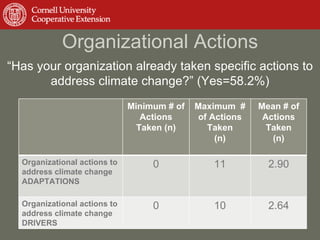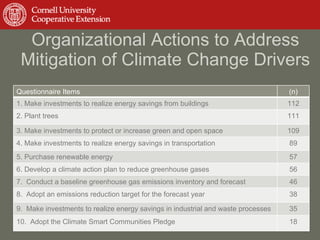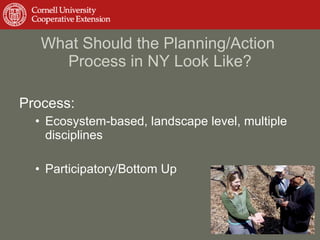Resilience in the Face of Climate Change: Empowering Natural Resource Managers and Professionals through Extension Education
- 1. Resilience in the Face of Climate Change: Empowering Natural Resource Managers and Professionals through Extension Education Allison Chatrchyan, Ph.D. Shorna Broussard Allred, Ph.D. Rebecca Schneider, Ph.D. Presentation to ANREP Conference, June 28, 2010, Fairbanks, AK
- 2. NY's Climate is Already Changing Between 1970-2000, average annual temps. in the New York rose almost 2° warmer. Average winter temps. have risen 4°. More frequent days with temps. above 90°F; Longer growing season; Increased heavy precipitation; more winter precipitation falling as rain; reduced snowpack; earlier spring snowmelt resulting in earlier peak river flows. Source: http://www.globalchange.gov .
- 3. Projected Changes in New York Over the next several decades, temperatures in the Northeast are projected to rise an additional 2.5 to 4°F in winter and 1.5 to 3.5°F in summer. Health Effects: extreme heat; negative air quality; increase in vector-borne diseases. More extreme weather events; more frequent storm flooding; longer summer droughts Effects on Infrastructure: water treatment plants; rail & bridges Changes to Ecosystems & Agriculture
- 4. Strategic Directions in NY Federal Level: U.S. Global Change Research Program (USGCRP) NIFA – Climate Change Focus 3 New NSF Reports Climate Change Legislation New York: NYS Office of Climate Office, NYSERDA Mitigation: “80 by 50”, RGGI NYS Energy Plan: Climate Chapter Adaptation: NYSERDA Climaid Report Local Governments: ICLEI + NYS Pledge
- 5. Current Cornell Climate Research: Cornell DNR: Smith Lever Funding for NYS Climate Adaptation Stakeholders & Municipal Officials Surveys – Rebecca Schneider, Shorna Allred et al. Cornell Dep't. Earth & Atmospheric Sciences: NYS Climate Office (NOAA) – Art DeGaetano, Climate Modeling: Natalie Mahowald Work on NYSERDA Climaid Report – Susan Riha, Rebecca Schneider, Art DeGaetano Climate & Agriculture – David Wolfe and other research projects…
- 6. CCE Energy Team Created ~Spring 2010 Increase communication between CU & CCE – 56 county association and NYC office Strengthen CCE System Capacity via Webinars (Adobe Connect) & Workshops to train educators Apply for funding proposals w/ extension & community impacts components Cornell & CCE Energy & Climate Research & Extension
- 7. Cornell DNR Climate Change Study Empowering Land Managers to increase Resilience of NY’s Natural Resources in the Face of Regional Climate Change Cornell Smith Lever Funding 2007-10 for three year study. Collaboration between faculty & CCE Extension in survey design & outputs.
- 8. Cornell Project Team Principle Investigators: Rebecca Schneider, Dept. Natural Resources Shorna Broussard Allred, Dept. Natural Resources Paul Curtis, Dept. Natural Resources Peter Smallidge, Dept. Natural Resources Collaborators: Bernd Blossey, Dept. Natural Resources Allison M. Chatrchyan, CCE Energy/Climate Team Jonathan Comstock, Dept. of Horticulture Gary Goff, Dept. Natural Resources Kristi Sullivan, Dept. Natural Resources Mike Farrell, Dept. Natural Resources, Keith Tidball, Dept. Natural Resources David Wolf, Dept. of Horticulture
- 9. Goals of DNR Study: Evaluate the current state of knowledge and attitudes about climate change of different natural resource professionals across NY (Land/Forestry, Water Resources, Invasives and Wildlife/Fisheries Managers) Ask professionals to identify key vulnerabilities and adaptations to climate change. Paired with Survey of Municipal Officials. Use the data to identify needs & develop workshops, materials & recommendations.
- 10. Determine Resource Managers Views of: General views on climate change; risks and issues associated with climate change on natural resources Adaptation tools which might successfully address climate change. Attitudes towards various state and local policy solutions to address climate change. If/if not professionals are already taking action in their positions to address climate change (why/why not). Benefits/obstacles of taking action. Information Needs/Tools to help implement solutions and adaptations.
- 11. Survey Methodology Web survey of natural resource professionals in New York State (N=1,488) Conducted November 2009-January 2010 5 e-mail contacts Response Rate=31.8% (n=448) Non-respondent bias analysis Telephone survey follow-up to non-respondents Conducted January 2010 (n=100)
- 13. Multiple Areas of Expertise
- 14. Climate Change Knowledge “How would you assess your current level of knowledge about potential climate change impacts in NY State?”
- 15. Climate Change Attitudes (1=Strongly Disagree, 2=Disagree, 3=Neutral, 4=Agree, 5=Strongly Agree) Questionnaire Item Mean 1. The science indicates our climate is changing 4.35 2. There is sufficient evidence that over the coming decade, climate change will affect the natural resources with which I work 4.09 3. Humans are responsible for climate change 3.84 4. I already see evidence of how climate change is affecting NY’s natural resources 3.80 5. My personal actions will have an influence on climate change 3.65 6. My personal actions will encourage others to take action 3.61 7. There is sufficient information available on how to address climate change impacts at the local level 2.28 8. There is sufficient information available on the local effects of climate change 2.44 9. I do not currently see a need to address climate change mitigation in the work that I do 2.25 10. I do not currently see a need to address climate change adaptation in the work that I do 2.10
- 16. Organizational Actions “ Has your organization already taken specific actions to address climate change?” (Yes=58.2%) Minimum # of Actions Taken (n) Maximum # of Actions Taken (n) Mean # of Actions Taken (n) Organizational actions to address climate change ADAPTATIONS 0 11 2.90 Organizational actions to address climate change DRIVERS 0 10 2.64
- 17. Organizational Actions to Adapt to Anticipated Climate Change Questionnaire Items (n) 1. Conduct outreach and education about climate change 144 2. Work through new or existing partnerships with local groups, organizations, or agencies to address climate change issues 104 3. Collect data to monitor climate change 78 4. Develop a climate action plan 66 5. Practice adaptive management 57 6. Plan on long-term horizons (10 years or more) 61 7. Provide funding for climate change research 42 8. Plan for specific climate change adaptations at the local level 41 9. Conduct a climate change vulnerability or risk assessment 30 10. Implement a climate action plan 27 11. Monitor and evaluate a climate action plan 22 12. Develop a comprehensive flood mitigation plan or program 17
- 18. Organizational Actions to Address Mitigation of Climate Change Drivers Questionnaire Items (n) 1. Make investments to realize energy savings from buildings 112 2. Plant trees 111 3. Make investments to protect or increase green and open space 109 4. Make investments to realize energy savings in transportation 89 5. Purchase renewable energy 57 6. Develop a climate action plan to reduce greenhouse gases 56 7. Conduct a baseline greenhouse gas emissions inventory and forecast 46 8. Adopt an emissions reduction target for the forecast year 38 9. Make investments to realize energy savings in industrial and waste processes 35 10. Adopt the Climate Smart Communities Pledge 18
- 19. Influencing Factors for Actions Taken “In taking the actions to adapt to or mitigate climate change impacts, how important are or were the following factors?” 1=Not important, 2=Slightly important, 3=Somewhat important, 4=Important, 5=Very important Mean SD Proactive Leadership 3.89 0.83 Local Impacts 3.51 0.95 Fiscal Savings 3.27 1.25 Top-Down Mandate 3.19 1.09 Inaction of Government 2.94 1.38
- 20. Barriers to Taking Action “To what extent are the following barriers to taking action on climate change at the scale at which you work in New York?” 1=Not a barrier, 2=Minimal barrier, 3=Slight barrier, 4=Moderate barrier, 5=Significant barrier Mean SD Lack of Resources (Financial & Human) 3.54 1.03 Lack of perceived threat & understanding 3.26 1.09 Financial Costs 3.67 1.02 Inaction of Government 3.01 1.27 Intra-Organizational Issues 2.01 1.10
- 21. Importance and Feasibility of Adaptations for Water Resources Very Important and Very Feasible Very Important and Less Feasible Low Importance and Low Feasibility Low Importance and High Feasibility 5 0 -5 -5 5 Feasibility Importance Importance Feasibility
- 22. Protect or Restore forests to reduce runoff and increase rain infiltration
- 23. Increase monitoring of water quantity (stream flow) and water quality (temperature, contaminants)
- 24. Develop Monitoring and Rapid Response Programs for Aquatic Invasives
- 25. Develop flood preparedness and emergency response programs at the state, county, and town levels in high risk areas
- 26. Create incentives for protection of water resources through low-impact development, better site design, fewer impervious surfaces, etc.
- 27. Plan Infrastructure Projects with Future Climate Changes in Mind
- 28. Resources Needed “How useful would the following resources be in addressing natural resource impacts and issues at the local level that result from climate change?” 1=Not at all useful, 2=Slightly useful, 3=Somewhat useful, 4=Useful, 5=Very useful Mean SD Info on Climate Change in General and Specific Local Projections 4.09 0.84 Regulations, Incentives, Planning Tools 3.96 0.82 Research and Data Needs 3.90 0.78
- 29. Who should be Involved in Prioritizing Climate Change Planning/Action in NY? Academia/Expert scientists State government Local municipalities, planners, etc. Citizen/stakeholders Expert scientists Federal government NGO’s, non-profit organizations Natural resource managers
- 30. What Should the Planning/Action Process in NY Look Like? Process: Ecosystem-based, landscape level, multiple disciplines Participatory/Bottom Up
- 31. “ Education is important so people can make informed decisions” “ PowerPoint's with visuals, photos, graphs, numbers, and presenters who are provided with an extensive script so they can answer questions. Train and use local people to be presenters; they have credibility in their communities.” Open Ended Comments:
- 32. “ It will require outreach, education, and public input.” “ Travelling workshops to educate and get citizens involved in the decision- making process—to increase buy-in and increase support for hard choices that politicians are afraid to make if they don’t have strong support of their voters!” “ Community must be created and nurtured.” Open Ended Comments:
- 33. Relevant Stakeholder Groups Develop Differentiated Outreach Materials for: Forestry/Land Use Professionals Water Resource Professionals Invasives/Fisheries/Wildlife Managers Municipal Officials: Win/Win Solutions/Infrastructure Planning Agriculture Community
- 34. Next Steps Results from Natural Resource Professionals Survey Responses/Results from Municipal Officials Survey (Summer/Fall 2010) Compare results of two groups Data to provide basis for developing differentiated climate change outreach materials to natural resource professionals & municipal officials Incorporate climate concepts into existing programs & materials
- 35. CCE Energy & Climate Team: Climate Focus Assess Existing Climate Change outreach materials Assess Data from NY Climate Data/Results from Land Managers and Municipal Survey, NYSERDA Climaid Report, NYS Climate Office (NOAA) Develop Educational/Outreach materials on climate change - Fact Sheets, Posters, Powerpoints, Webinars Differentiated Audiences: Land Use Managers, Agriculture, Municipalities & the Public
- 36. Building a Climate Change Extension Program Addressing Climate Change affecting Natural Resources: Identify proximal source of climate change data for your region; Identify key partners: universities, extension educators, NOAA, soil and water conservation, other NGOs, local and county governments are key; Conduct a vulnerabilities and adaptation assessment for your area – can be smaller scale; Identify key vulnerable stakeholders: Could include Farmers, Fisheries, Seniors, Private Well Owners…. Identify Needs & Build on Existing Programs ~ MFOs or Watershed Stewards to incorporate climate change information.
- 37. Contacts/Questions: Allison Chatrchyan, Ph.D., CCE Dutchess & CCE Energy Team ~ Climate Change Email: [email_address] , Tel: 845-677-8223 Shorna Allred, Ph.D., Cornell University DNR Email: [email_address] , Tel: 607-255-2149 Rebecca Schneider, Ph.D. Cornell University DNR Email: [email_address] ,Tel: 607-255-2110
Editor's Notes
- #5: The U.S. Global Change Research Program (USGCRP) coordinates and integrates federal research on changes in the global environment and their implications for society. The USGCRP began as a presidential initiative in 1989 and was mandated by Congress in the Global Change Research Act of 1990 . Thirteen departments and agencies participate in the USGCRP, which was known as the U.S. Climate Change Science Program from 2002 through 2008. Mitigation vs Adaptation The Regional Greenhouse Gas Initiative (RGGI) is the first mandatory, market-based effort in the United States to reduce greenhouse gas emissions. Ten Northeastern and Mid-Atlantic states have capped and will reduce CO 2 emissions from the power sector 10% by 2018. States sell nearly all emission allowances through auctions and invest proceeds in consumer benefits: energy efficiency, renewable energy, and other clean energy technologies.
- #6: ClimAID: Integrated Assessment for Effective Climate Change Adaptation Strategies in New York State
- #14: Areas of expertise were not mutually exclusive. While most respondents (47%) reported only 1 area of expertise, 30% reported two areas of expertise, 14% reported 3 areas of expertise, and 9% reported four or more areas of expertise
- #16: -Data show that natural resource managers believe science about climate change and some are already seeing impacts -Data show clear information needs; managers DO NOT think there is sufficient information available on how to address climate impacts and effects at the local level (Item # 7 and #8 have a mean of 2.44 and 2.25)
- #18: -only people that answered “Yes” to “Has your organization already taken specific actions to address climate change?” answered this question -outreach and education are more frequently undertaken actions by organizations (#1) -importance of partnerships (#2)
- #19: -only people that answered “Yes” to “Has your organization already taken specific actions to address climate change?” answered this question
- #20: Influencing Factors: each of these is a composite score (mean) of what factors influenced most the organizational actions to adapt to climate change and to address drivers Proactive Leadership : Influenced by being a responsible leader, developing useful partnerships, thinking globally and acting locally, and getting a head start on inevitable changes. THIS WAS MOST IMPORTANT INFLUENCING FACTOR FOR ACTION; IMPORTANCE OF DEVELOPING LEADERSHIP SKILLS and BEING PROACTIVE vs REACTIVE Local Impacts : threats and impacts at the local level and state level, belief that scientific evidence about climate change is real, concerns about social equity. 2 nd MOST IMPORTANT INFLUENCING FACTOR Fiscal Savings : Belief that responding to climate change will result in short and long-term fiscal savings. 3 rd MOST IMPORTANT INFLUENCING FACTOR Top-Down Mandate : Influenced by direction from leadership that actions should be taken, responding to mandate from above, or constituent pressure to take action. 4 th MOST IMPORTANT INFLUENCING FACTOR Inaction of Govt .: Lack of action at local, state, and federal levels. 5 th MOST IMPORTANT INFLUENCING FACTOR
- #21: Barriers Composite Scores of what barriers there are to organizational actions to adapt to climate change and to address drivers Lack of Resources : barriers associated with lack of funding to develop new programs, lack of staff to take on new initiatives, feeling overwhelmed and not knowing where to start, not enough technical assistance. THIS WAS MOST IMPORTANT BARRIER Lack of Perceived threat/ understanding : Barriers associated with lack of consensus that climate change is real and a current problem, lack of perceived future threat, impacts not being felt at the local level, belief that higher govt entity should take action, no constituent pressure to take action. 2 nd MOST IMPORTANT BARRIER Financial Costs : barriers associated with high costs to respond to and adapt to climate change, savings not being realized immediately, and not relevant given other pressing problems/demands. 3 rd MOST IMPORTANT BARRIER Inaction of Government : barrier is inaction of government at all levels (local, state, federal). 4 th MOST IMPORTANT BARRIER Intra-organizational issues : barriers associated with conflict within my agency/organization and not perceived by manager/supervisor as part of my job description. 5 th MOST IMPORTANT BARRIER
- #29: Resources Needed Composite Scores General and Local Info Needs : resources needed about information about climate change in general, specific projections of climate change impacts to the local level (rainfall, temps, sea-level, etc.). THIS WAS MOST IMPORTANT RESOURCE NEEDED. CLEAR ROLE FOR EXTENSION TO HELP BRING SCIENTIFIC INFO TO LOCAL LEVEL REGARDING IMPACTS Regs/Incentives/Planning Tools : resources associated with model ordinances that can be adopted by local governments, incorporation of climate change into state regs, incentives for adopting specific actions, revised management plans reflecting climate impacts, funding/grants for adaptation, educational resources, information on how to assess vulnerability, information on economic value of ecosystem services. THIS WAS 2 nd HIGHEST RATED SET OF RESOURCES Research and Data Needs: Resources associated with applied research about effects of climate resources, habitats, species, increased inter-disciplinary communication and partnerships, additional research on effective adaptations, citizen volunteers for monitoring changes in climate. THIS WAS 3 rd HIGHEST RATED SET OF RESOURCES NEEDED.
- #30: These are in response to an open-ended question and are ordered from most frequent responses to least frequent responses --local involvement was key as was a focus on a collaborative, participatory process
- #31: These are in response to an open-ended question and are ordered from most frequent responses to least frequent responses -Important to emphasize the role of extension in facilitating participatory process, bringing together stakeholders
- #32: Open-ended responses to question about who should be involved in planning for climate change in NY and how it should be done
- #33: Verbatim Open-ended responses to question about who should be involved in planning for climate change in NY and how it should be done





































![Contacts/Questions: Allison Chatrchyan, Ph.D., CCE Dutchess & CCE Energy Team ~ Climate Change Email: [email_address] , Tel: 845-677-8223 Shorna Allred, Ph.D., Cornell University DNR Email: [email_address] , Tel: 607-255-2149 Rebecca Schneider, Ph.D. Cornell University DNR Email: [email_address] ,Tel: 607-255-2110](https://image.slidesharecdn.com/anrep2010ppt-allredchatrchyanfinal-110204121325-phpapp02/85/Resilience-in-the-Face-of-Climate-Change-Empowering-Natural-Resource-Managers-and-Professionals-through-Extension-Education-37-320.jpg)